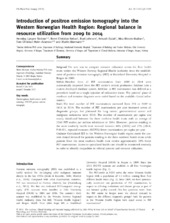| dc.contributor.author | Stokmo, Henning Langen | en_US |
| dc.contributor.author | Reitan, Bernt Christian | en_US |
| dc.contributor.author | Johnsen, Boel | en_US |
| dc.contributor.author | Gulati, Ankush | en_US |
| dc.contributor.author | Kleven-Madsen, Nina | en_US |
| dc.contributor.author | Adamsen, Tom Christian Holm | en_US |
| dc.contributor.author | Biermann, Martin | en_US |
| dc.date.accessioned | 2016-01-28T13:52:26Z | |
| dc.date.available | 2016-01-28T13:52:26Z | |
| dc.date.issued | 2015 | |
| dc.Published | Clinical Physiology and Functional Imaging 2015 | eng |
| dc.identifier.issn | 1475-097X | |
| dc.identifier.uri | https://hdl.handle.net/1956/11016 | |
| dc.description.abstract | Background: The aim was to compare resource utilization across the four health trusts within the Western Norway Regional Health Authority since the establishment of positron emission tomography (PET) at Haukeland University Hospital in Bergen in 2009. Methods: Metadata from all PET examinations from 2009 to 2014 were automatically imported from the PET centre's central production database into a custom-developed database system, MDCake. A PET examination was defined as a procedure based on a single injection of radioactive tracer. The patients' place of residence and tentative diagnosis were coded based on the available clinical information. Results: The total number of PET examinations increased from 293 in 2009 to 1616 in 2014. The number of PET examinations per year increased across all diagnostic groups, but plateaued for lung cancer, gastrointestinal cancer and malignant melanoma since 2013. The number of examinations per capita was evenly distributed between the three northern health trusts with an average of 1260 PET studies per million inhabitants in 2014. However, patients residing in the most southerly health trust received between 44% (2010) and 27% (2014; P<0·001, repeated measures ANOVA) fewer examinations per capita per year. Conclusion: Centralized PET in the Western Norwegian health region meets the current clinical demand for patients residing in the three northern health trusts while patients from the most southern health trust receive approximately 30% fewer PET examinations. Access to specialized health care should be monitored routinely in order to identify inequalities in referral patterns and resource utilization. | en_US |
| dc.language.iso | eng | eng |
| dc.publisher | Wiley | eng |
| dc.rights | Attribution CC BY | eng |
| dc.rights.uri | http://creativecommons.org/licenses/by/4.0/ | eng |
| dc.subject | Fluordeoxyglucose | eng |
| dc.subject | health services | eng |
| dc.subject | health technology | eng |
| dc.subject | PET/CT | eng |
| dc.subject | positron emission tomography | eng |
| dc.title | Introduction of positron emission tomography into the Western Norwegian Health Region: Regional balance in resource utilization from 2009 to 2014 | en_US |
| dc.type | Peer reviewed | |
| dc.type | Journal article | |
| dc.date.updated | 2015-12-29T14:32:22Z | |
| dc.description.version | publishedVersion | en_US |
| dc.rights.holder | Copyright 2015 The Authors | |
| dc.identifier.doi | https://doi.org/10.1111/cpf.12335 | |
| dc.identifier.cristin | 1304474 | |

